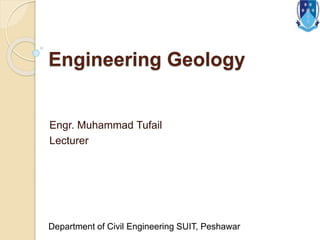
Lecture 1-1.pdf
- 1. Engineering Geology Engr. Muhammad Tufail Lecturer Department of Civil Engineering SUIT, Peshawar
- 2. Lecture 1
- 3. Overview of Course outline Introduction to Engineering Geology Introduction to Engineering Seismology
- 4. Geology & Seismology Geology “is the science devoted to the study of the Earth, particularly the solid Earth and the rocks that compose it”. Seismology “is the scientific study of earthquakes and the propagation of elastic waves through the Earth”.
- 5. Engineering Geology Engineering geology is the application of geological data, techniques and principles to the study of rock and soil surficial materials and ground water. This is essential for the proper location, planning, design, construction, operation and maintenance of engineering structure.
- 6. Engineering Geology Importance of Geology in Civil Engineering Origin of Earth and Interior of Earth
- 7. Engineering Geology Properties and Identification of Minerals Classification of Rock Formation of Rock Weathering and Erosion Faults
- 8. Engineering Geology Geological Materials used in Civil Engineering Stability of rock and soil: Land slides
- 9. Engineering Seismology Importance of seismology in civil engineering practice Continental drift, plate tectonic and elastic rebound theory Types of Seismic waves Earthquakes: Causes and effects Intensity and magnitude scale Earthquake observation: Seismograph and accelerograph Characteristics of Strong Motion: Amplitude, Duration and Frequency
- 10. Engineering Seismology Seismic Hazard Local site Effects Seismic risk: Vulnerability, Exposure and Hazard
- 11. Importance of Geology in Civil Engineering Serve civil engineering to provide information in 3 most important areas Resources for construction; aggregates, fills and borrows. Finding stable foundations. Mitigation of geological hazards; Identify problems, evaluate the costs, provide information to mitigate the problem
- 12. Layers of Earth It is important to note that there has been, so far, no drill that has penetrated the surface of the earth more than a few kilometers. Almost all information about the internal structure of the earth is inferred from observed characteristics and propagation (travel rates and reflections) of seismic waves. Magnetic and gravitational observations also help complete the picture.
- 13. Cont.. The earth is divided into three main layers: Core (Inner core, outer core), mantle and crust. The core is composed mostly of iron (Fe) and is so hot that the outer core is molten, with about 10% sulphur (S). The inner core is under such extreme pressure that it remains solid. Most of the Earth's mass is in the mantle, which is composed of iron (Fe), magnesium (Mg), aluminum (Al), silicon (Si), and oxygen (O) silicate compounds. At over 1000 degrees C, the mantle is solid but can deform slowly in a plastic manner.
- 14. Cont..
- 15. Crust The crust is much thinner than any of the other layers, and is composed of the least dense calcium (Ca) and sodium (Na) aluminum-silicate minerals. Being relatively cold, the crust is rocky and brittle, so it can fracture in earthquakes. The shell of the earth, the crust, can be said to have two different thicknesses. Under the oceans, it is relatively thin. It varies in thickness from 5 to 8 km. Under the land masses, it is relatively thick. The thickness of the continental crust varies from 10 to 65 km.
- 16. Cont.. The eggshell analogy for the crust is not an exaggeration. It is paper thin compared with the radius of the earth which is approximately 6400 km. The total weight of the continental crust is less than 0.3% of the weight of the earth. Variations in the crust thickness are compensated by the weight of the water and the differences in the specific gravities of the crust under the oceans (3.0 to 3.1) and under the continents(2.7 to 2.8).
- 17. The Moho The Moho Discontinuity, refers to a zone or a thin shell below the crust of the earth that varies in thickness from 1 to 3 km.
- 18. Cont.. In seismology, the term "discontinuity" is used in its general sense. It refers to a change over a short distance of a material property. In this case, the "short distance" may be as long as 3 km, a trifle compared with the radius of the earth. In that zone, the P-wave velocity has been observed to increase from approximately 6 to approximately 8 km/sec. The Moho is considered to be the boundary between the crust and the mantle. The increase in P-wave velocity is ascribed to change in composition of the medium. Rocks of the mantle are poorer in silicon but richer in iron and magnesium
- 19. Mental The mantle can be thought of having three different layers. The separation is made because of different deformational properties in the mantle inferred from seismic wave measurements. i. Lithosphere ii. Asthenosphere iii. Mesosphere
- 20. Cont.. Lithosphere The upper layer is stiff. It is presumed that if the entire mantle had been as stiff, the outer shell of the earth would have been static. This stiff layer of the mantle and the overlying crust are referred to as the lithosphere. The lithosphere is approximately 80-km thick Asthenosphere Beneath the lithosphere is a soft layer of mantle called the asthenosphere. Its thickness is inferred to be several times that of the lithosphere.
- 21. Cont.. Mesosphere Mesosphere is the lowest layer of the mantel The thickness of the mantel is not well known
- 22. Core At a depth of approximately 2900 km, there is a large reduction (on the order of 40%) in the measured velocity of seismic waves. The boundary between the mantle and the core is assumed to be at this depth. Because no S-wave has been observed to travel through the material below this boundary for a thickness of approximately 2300 km, it has been inferred that the core comprises two layers. The 2300-km thick outer layer which is in a molten state and an 1100-km thick inner layer which is solid.